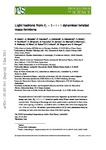Light hadrons from Nf=2+1+1 dynamical twisted mass fermions
| dc.contributor.author | Reker, S | |
| dc.contributor.author | Baron, R | |
| dc.contributor.author | Blossier, B | |
| dc.contributor.author | Boucaud, P | |
| dc.contributor.author | Carbonell, J | |
| dc.contributor.author | Deuzeman, A | |
| dc.contributor.author | Drach, V | |
| dc.contributor.author | Farchioni, F | |
| dc.contributor.author | Gimenez, V | |
| dc.contributor.author | Herdoiza, G | |
| dc.contributor.author | Jansen, K | |
| dc.contributor.author | Michael, C | |
| dc.contributor.author | Montvay, I | |
| dc.contributor.author | Pallante, E | |
| dc.contributor.author | Pene, O | |
| dc.contributor.author | Urbach, C | |
| dc.contributor.author | Wagner, M | |
| dc.contributor.author | Wenger, U | |
| dc.date.accessioned | 2018-07-25T10:54:52Z | |
| dc.date.available | 2018-07-25T10:54:52Z | |
| dc.date.issued | 2011-06-06 | |
| dc.identifier.issn | 1824-8039 | |
| dc.identifier.uri | http://hdl.handle.net/10026.1/11899 | |
| dc.description | 7 pages, 5 figures, talk presented at the XXVIII International Symposium on Lattice Field Theory, Lattice2010, June 14-19, 2010 Villasimius, Italy | |
| dc.description.abstract |
We present results of lattice QCD simulations with mass-degenerate up and down and mass-split strange and charm (Nf = 2 + 1 + 1) dynamical quarks using Wilson twisted mass fermions at maximal twist. The tuning of the strange and charm quark masses is performed at three values of the lattice spacing a ≈ 0.06 fm, a ≈ 0.08 fm and a ≈ 0.09 fm with lattice sizes ranging from L ≈ 1.9 fm to L ≈ 3.9 fm. We perform a preliminary study of SU(2) chiral perturbation theory by combining our lattice data from these three values of the lattice spacing. | |
| dc.format.extent | 123- | |
| dc.language.iso | en | |
| dc.publisher | Sissa Medialab | |
| dc.subject | hep-lat | |
| dc.subject | hep-lat | |
| dc.title | Light hadrons from Nf=2+1+1 dynamical twisted mass fermions | |
| dc.type | conference | |
| dc.type | Conference Proceeding | |
| plymouth.author-url | http://arxiv.org/abs/1101.0518v1 | |
| plymouth.date-start | 2010-06-14 | |
| plymouth.volume | 105 | |
| plymouth.conference-name | The XXVIII International Symposium on Lattice Field Theory | |
| plymouth.publication-status | Published | |
| plymouth.journal | Proceedings of The XXVIII International Symposium on Lattice Field Theory — PoS(Lattice 2010) | |
| dc.identifier.doi | 10.22323/1.105.0123 | |
| plymouth.organisational-group | /Plymouth | |
| plymouth.organisational-group | /Plymouth/Faculty of Science and Engineering | |
| plymouth.organisational-group | /Plymouth/Faculty of Science and Engineering/School of Engineering, Computing and Mathematics | |
| plymouth.organisational-group | /Plymouth/REF 2021 Researchers by UoA | |
| plymouth.organisational-group | /Plymouth/REF 2021 Researchers by UoA/EXTENDED UoA 10 - Mathematical Sciences | |
| plymouth.organisational-group | /Plymouth/REF 2021 Researchers by UoA/UoA10 Mathematical Sciences | |
| plymouth.organisational-group | /Plymouth/Users by role | |
| plymouth.organisational-group | /Plymouth/Users by role/Academics | |
| dc.identifier.eissn | 1824-8039 | |
| dc.rights.embargoperiod | Not known | |
| rioxxterms.versionofrecord | 10.22323/1.105.0123 | |
| rioxxterms.licenseref.uri | http://www.rioxx.net/licenses/all-rights-reserved | |
| rioxxterms.type | Conference Paper/Proceeding/Abstract |


